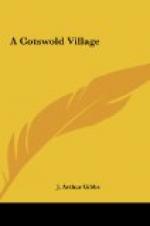Some of the farmers in this district are yeoman princes, not only possessing their own freeholds, but farming a thousand or fifteen hundred acres in addition. Mr. Garne, of Aldsworth, is a fine specimen of this class. He makes a speciality of the original pure-bred Cotswold sheep, and his rams being famous, he is able to do very well, in spite of the fact that there is little demand for the old breed of sheep, the mutton being of poor quality and the wool coarse and rough. Mr. Garne carries off all the prizes at “the Royal” and other shows with his magnificent sheep. A cross between the Hampshire downs and the Cotswold sheep has been found to give excellent mutton, as well as fine and silky wool. The cross breed is gradually superseding the native sheep. Mr. Hobbs, of Maiseyhampton, is famous for his Oxford downs. These sheep are likewise superior to the Cotswold breed.
Barley does uncommonly well on the light limestone soil of these hills. The brewers are glad to get Cotswold barley for malting purposes. Fine sainfoin crops are grown, and black oats likewise do well. The shallow, porous soil requires rain at least once a week throughout the spring and summer. The better class of farmer on these hills does not have at all a bad time even in these days. Very often they lead the lives of squires, more especially in those hamlets where there is no landowner resident. Hunting, shooting, coursing, and sometimes fishing are enjoyed by most of these squireens, and they are a fine, independent class of Englishman, who get more fun out of life than many richer men, They will tell you with regard to the labourers that the following adage is still to be depended upon:—
“Tis the same
with common natures:
Use
’em kindly they rebel;
But be rough as
nutmeg-graters,
And
the rogues obey you well.”
[Illustration: An Old Cottage. 087.png]
CHAPTER IV.
THE LANGUAGE OF THE COTSWOLDS, WITH SOME ANCIENT SONGS AND LEGENDS.
A very marked characteristic of the village peasant is his extraordinary honesty. Not one in ten would knock a pheasant on the head with his stick if he found one on his allotment among the cabbages. Rabbit poachers there are, but even these are rare; and as for housebreaking and robbery, it simply does not exist. The manor house has a tremendous nail-studded oak door, which is barred at night by ponderous clamps of iron and many other contrivances; but the old-fashioned windows could be opened by any moderately skilful burglar in half a minute. There is absolutely nothing to prevent access to the house at night, whilst in the daytime the doors are open from “morn till dewy eve.” Most of the windows are innocent of shutters. When in Ireland recently, I noticed that the gates in every field were immensely strong, generally of iron, with massive pillars of stone on either side; but in spite of these precautions there was usually a gap in the hedge close by, through which one might safely have driven a waggon. This reminded one of the Cotswold manor house and its strongly barricaded oak door, surrounded by windows, which any burglar could open “as easy as a glove,” as Tom Peregrine would say.




